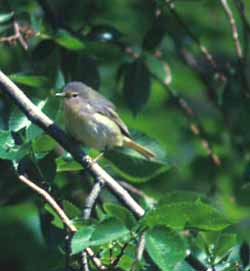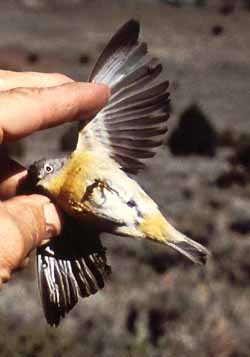 Unfortunately, I do not have very good photos to illustrate this particular
problem, which seems to be becoming more and more common with 1-2 such
errors each fall migration (I have played with this photo in PhotoShop®
to make the head/back duller gray). The mistake usually happens when a
real Virginia's Warbler is found by an experienced and careful observer
at a local vagrant trap, and then others "chase" it on following days.
The "chasers" find a bird that is mostly grayish with an eyering, a yellowish
wash to the breast , and brighter yellow on the undertail coverts, and
then report the "continuing presence of the Virginia's Warbler" (concurrently
checking it off on their personal list). Alas, in a number of specific
cases, other experienced observers were at the same site that day and saw
only a dull wash-out Yellow Warbler, quite possibly of the Alaska
race rubiginosa, or maybe even of the southwestern sonorana
(if they occur here?), but much paler and duller than the common migrant
of the western race brewsteri (Dunn & Garret, 1997, A Field
Guide to Warblers of North America, Houghton Mifflin, does a nice job
of illustrating different races -- including dull fall females -- but does
not discuss the problem of mistaken i.d. with Virginia's Warbler). In coastal
California we get a lot of migrant Yellow Warblers, mostly bright brewsteri,
but smaller numbers of other races occur. These dull birds can be mistaken
by the unwary for something else, and especially when the observer is "chasing"
something like a Virginia's Warbler. Yellow Warblers may have very prominent
white eyerings, leading one astray. Dull fall females can be very plain
grayish with only a yellowish wash to breast, and a brighter yellowish
wash to the undertail coverts. This causes the problem at hand. The observers
fail to note the compact, short-tailed shape of Yellow Warbler (yet typically
Dendroica),
the yellow spots in the tail (very obvious if the undertail itself is seen,
as in this photo), and the yellowish edges to wing coverts and secondaries.
Unfortunately, I do not have very good photos to illustrate this particular
problem, which seems to be becoming more and more common with 1-2 such
errors each fall migration (I have played with this photo in PhotoShop®
to make the head/back duller gray). The mistake usually happens when a
real Virginia's Warbler is found by an experienced and careful observer
at a local vagrant trap, and then others "chase" it on following days.
The "chasers" find a bird that is mostly grayish with an eyering, a yellowish
wash to the breast , and brighter yellow on the undertail coverts, and
then report the "continuing presence of the Virginia's Warbler" (concurrently
checking it off on their personal list). Alas, in a number of specific
cases, other experienced observers were at the same site that day and saw
only a dull wash-out Yellow Warbler, quite possibly of the Alaska
race rubiginosa, or maybe even of the southwestern sonorana
(if they occur here?), but much paler and duller than the common migrant
of the western race brewsteri (Dunn & Garret, 1997, A Field
Guide to Warblers of North America, Houghton Mifflin, does a nice job
of illustrating different races -- including dull fall females -- but does
not discuss the problem of mistaken i.d. with Virginia's Warbler). In coastal
California we get a lot of migrant Yellow Warblers, mostly bright brewsteri,
but smaller numbers of other races occur. These dull birds can be mistaken
by the unwary for something else, and especially when the observer is "chasing"
something like a Virginia's Warbler. Yellow Warblers may have very prominent
white eyerings, leading one astray. Dull fall females can be very plain
grayish with only a yellowish wash to breast, and a brighter yellowish
wash to the undertail coverts. This causes the problem at hand. The observers
fail to note the compact, short-tailed shape of Yellow Warbler (yet typically
Dendroica),
the yellow spots in the tail (very obvious if the undertail itself is seen,
as in this photo), and the yellowish edges to wing coverts and secondaries.

A real Virginia's Warbler (a banded bird in hand) is shown at right. It has a very gray head and back and tail without any hint of tail spots or wing edgings. The patterns are crisp and well-defined, with yellow undertail coverts sharply set off from white belly. The bold white eyering is broad and complete without a hint of break (typically slightly broken in Yellow, although some look to be complete). The entire bird is a different shape than Yellow, being big-headed, short-tailed, and chunky. Virginia's Warbler often twitches its tail side-to-side (at best, Yellow "wags" its tail), and the call notes are quite different (metallic "chink" in Virginia's, a rich full Dendroica "chup" or "chip" in Yellow). And there are likely additional differences I have failed to mention -- in truth, the birds don't look much alike. It is the overzealous "chaser" that is the problem.